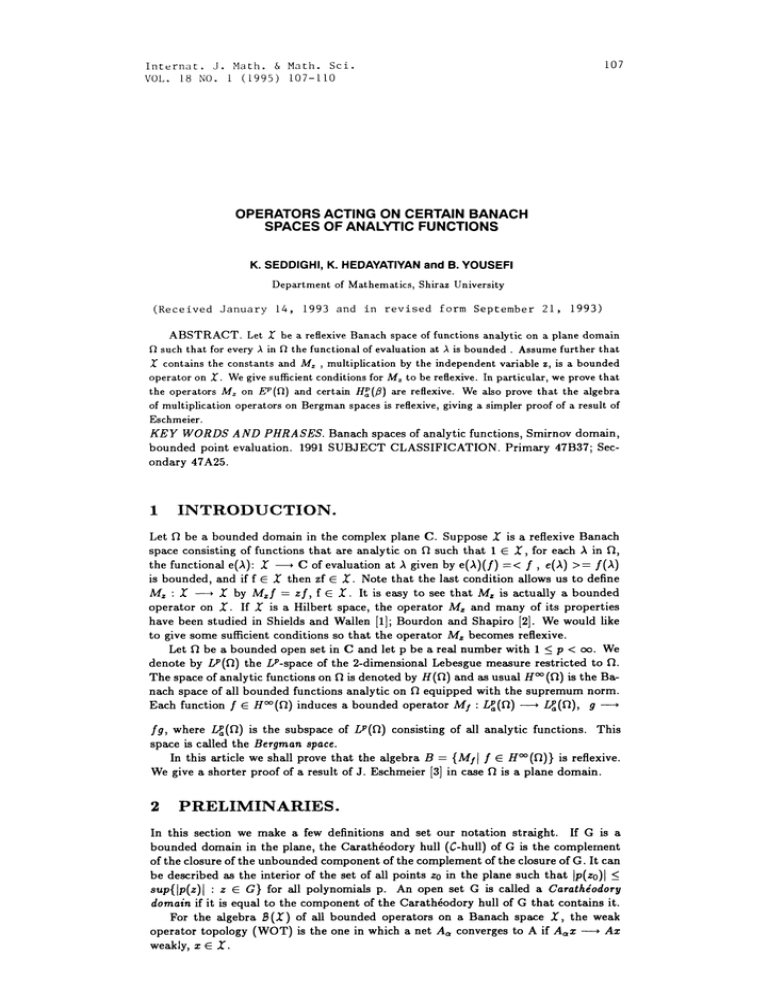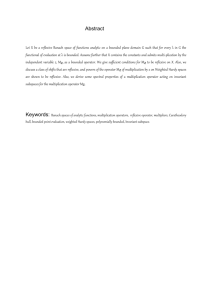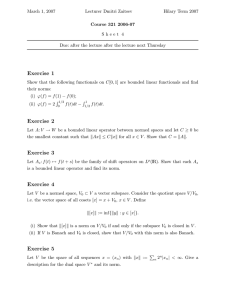OPERATORS BANACH SPACES OF ANALYTIC FUNCTIONS
advertisement

I07
Internat. J. Math. & Math. Sci.
(L995) I07-0
VOL. 18 NO.
OPERATORS ACTING ON CERTAIN BANACH
SPACES OF ANALYTIC FUNCTIONS
K. SEDDIGHI, K. HEDAYATIYAN and B. YOUSEFI
Department of Mathematics, Shiraz University
(Received 3anuary 14, 1993 and +/-n rev+/-sed form September 21, 1993)
ABSTRACT. Let be reflexive Banach space of functions analytic
plane domain
12 such that for every A in i2 the functional of evaluation at A is bounded Assume further that
X contains the constants and Mz multiplication by the independent variable is bounded
operator on ’. We give sufficient conditions for Mz to be reflexive. In particular, we prove that
reflexive. We also prove that the algebra
the operators Mz on EP{i} and certain H{}
of multiplication operators on Bergman spaces is reflexive, giving simpler proof of result of
Eschmeier.
.,
KEY WORDS AND PHRASES. Banach spaces of analytic functions, Smirnov domain,
bounded point evaluation. 1991 SUBJECT CLASSIFICATION. Primary 47B37; Secondary 47A25.
1
INTRODUCTION.
Let f be a bounded domain in the complex plane C. Suppose Z is a reflexive Banach
space consisting of functions that are analytic on fl such that
X, for each A in
C of evaluation at A given by e(A)(f)-< f, e(A) >- f(A)
the functional e(A)" Z
is bounded, and if f X then zf X. Note that the last condition allows us to define
X by Mzf zf, f X. It is easy to see that Mz is actually abounded
Mz X
operator on X. If Z is a Hilbert space, the operator Mz and many of its properties
have been studied in Shields and Wallen [1]; Bourdon and Shapiro [2]. We would like
to give some sufficient conditions so that the operator Mz becomes reflexive.
Let f be a bounded open set in C and let p be a real number with _< p < oo. We
denote by /.2(1) the LP-space of the 2-dimensional Lebesgue measure restricted to
The space of analytic functions on fl is denoted by H(fl) and as usual g (fl) is the Banach space of all bounded functions analytic on fl equipped with the supremum norm.
Each function f H(i2)induces a bounded operator Mf’ia(
ia(), g
fg, where L(i2) is the subspace of/)’(l) consisting of all analytic functions. This
space is called the Bergman space.
In this article we shall prove that the algebra S (Mf[ f H(fl)} is reflexive.
We give a shorter proof of a result of J. Eschmeier [3] in case fl is a plane domain.
2
PRELIMINARIES.
In this section we make a few definitions and set our notation straight. If G is a
bounded domain in the plane, the Carathodory hull (C-hull) of G is the complement
of the closure of the unbounded component of the complement of the closure of G. It can
be described as the interior of the set of all points z0 in the plane such that [p(z0)] _<
sup{[p(z)[: z G} for all polynomials p. An open set G is called a Carathodory
domain if it is equal to the component of the Carathodory hull of G that contains it.
For the algebra (.’) of all bounded operators on a Banach space X, the weak
Ax
operator topology (WOT) is the one in which a net As converges to A if Aax
weakly, x X.
K. SI2D1}IGHI, K. HEDAY,\IIYAN AND B. YOUSEF1
108
"
"
is called a
for every
A complex valued function on for which Cf
multgher of and the collection of all these multipliers IS denoted by 34(2") Because
X’. satisfies Mz’e(,) ,e(,).
Mz is a bounded operator on Z, the adjoInt M; rIn general each multiplier of Z determines a multiplication operator Me defined by
Me Cf, ,r Also Me’e( (,)e() It is well known that each multiplier is a
bounded analytic function, Shields and Wallen [1] Indeed I()1 _<_ ItMelt for each
c H() So is a bounded analytic function
in fl Also Mel
IS a subalgebra of 23(X) containing the Identity operator, then
Recall that If
and Alg Lat(’) is
Lat() is by definition the lattice of all nvariant subspaces of
the algebra of all operators B in 8(,r) such that Lat()c Lat(B) We say that
Alg Lat() Obvmusly a reflexive algebra is (WOT)-closed An
is reflexive if
operator A in (.’) IS said to be reflexive f Alg Lat(A)= W(A), where W(A)is the
smallest subalgebra of 8(Z) that contains A and the identity and is closed in the
weak operator topology.
Let A Al9 Lat(M,) and let N be a weak star closed invariant subspace of M; in
Z" Then +/- 34 Lat(M,)and hence +/-34 Lat(A). Therefore, (+/-34)+/- Lat(A*). Since
34 is weak star closed, 34 Lat(A’). Now the one-dimensional span of e(,) is invariant
under M;. Therefore, it is invariant under A*. We write A*e(A) (A)e(A), e a. So
fl. Using the Hahn-Banach theorem we see that the
< f A’e(,) >= (,)f(,);
Me.
linear span of {e(,)}aen is weak star dense in X*. Thus e 34(Z) and A
"
"
,
3
REFLEXIVITY.
In this section we consider a Banach space of functions analytic on a Carathodory
domain and give sufficient conditions for the operator of multiplication to be reflexive.
A circular domain is also considered.
THEOREM 1. Let gl be a Carathodory domain each point of which is a bounded
point evaluation for a reflexive Banach space Z of functions analytic on f2 which contains the constant functions and admits Mz as a bounded operator. Furthermore, if
IIMr, < CIIpl[n for every polynomial p, then Mz lS reflexive.
PROOF. Let A Alg Lat(M,). Then A
for some multiplier
H().
Let {Pn} be a sequence of polynomials such that supllpnlln <_ M for some constant M
and pr,(z)
(z), z e fl. Then IIMp,,ll <_ CIIpnll n <_ CM. Since X is reflexive, the
unit ball of is weakly compact. Therefore, the unit ball of B(.’) is (WOT) compact.
We may assume by passing to a subsequence if necessary, that Mp,
X (TOT) for
some operator X. Thus M,,e(,k)
X*e(,k) in the weak star topology. On the other
hand M,,e(,X) p,.,(.h)e()
(,k)e(,k) Me()in the weak star topology for every
,X
I2. Therefore, X*ea
and thusX*
Hence X-on Z, which
implies that A W(Mz) and Mz is reflexive.
II
Me
.
Mea
M.
Me
Now we use the technique of the proof of Theorem to give a short proof of a result
[3]. We let B {M.flf e g(f2)}, where f is a bounded domain and My
of Eschmeier
acts on
L (I2).
THEOREM 2. The algebra B is reflexive.
PROOF. Clearly BC_ Alg Lat(B). Let A hlg Lat(B). Because the one dimensional
for all f in H(fl), it is invariant under A*, and
span of e(A) is invariant under
therefore A M for some multiplier
Thus B is a reflexive algebra. []
Next we give a few examples of Banach spaces satisfying the hypothesis of Theorem
M
.
1.
EXAMPLE 3. Let fl be
an arbitrary simply connected Smirnov domain. Let
Define EP(fl) to be the set of all analytic functions f on fl such that there
exists a sequence of rectifiable Jordan curves C1, C2,... in i’l, tending to the boundary
in the sense that Cr, eventually surrounds each compact subdomain of f2 such that
<p<
x).
fc,, If(z)lr’ldzl -< M < c.
For a good source on EP(f) see Duren [4, Chapter
10]. Every
function of class E(12) has a nontangential limit almost everywhere on 0f, which does
not vanish on a set of positive measure unless f(z) 0. Furthermore,
If(z)lr’ldzl <
cx. It is convenient to identify E(fl) with its set of boundary functions. Thus
is a closed subspace of/_ev(0fl) which contains the set of all polynomials, and hence its
closure. Hence EP(fl) is a reflexive Banach space.
Clearly Mz is bounded and IIMpll <_ IlPlln for all polynomials p. Now we show that
fon
()PEI\TORS ON
_
BANACt-I SPAC! S
109
,
choose
each point of f s a bounded point evaluation for EP(f) For fixed n
C > 0 such that dlst(z,0n) _>_ C Let
EP() Then fP c E(f) and It has a Cauchy
representatmn
Thus each point of f/s a bounded point evaluation
Therefore f(z) < (1/2rC) fl
for Ev(). Finally, by Theorem 3 1, M, s reflexive
Further examples of Banach spaces satisfying the hypothesis of Theorem will be
presented We also deduce that Mz acting on these spaces are reflexive. We begin with
a defimtion.
DEFINITION 4. Let < p < c and let {/(n) be a sequence of pomtlve numbers
8(0) 1. We consider the space of sequences f {j;(n)} such that
with
ltg
I1()[Z()]
<
.
use the formal notation I(z)
,o ](n)z" for e D the umt disc in C
(See Shields [5] for p=2.). Let UP(fl) {I I(z) ,o ](n)z"" llIllp < } and
Ug() {I e HP(Z)l f(z) ,%0 ](n) zn is convergent in D}.
REMARK 5. Define the a-finite measure p on the positive integers by p(K)
neg (n) ,K g N. Because HP() LP(p) we conclude that HP(fl) is indeed a
We shall
reflexive Banh space.
REMARK 6. If {fl(n + 1)/fl(n)} is bounded, the operator of multiplication by
is a bounded operator on HP(). Indeed Mall- sup,
In the following examples let q be the conjugate of
+l/q =1).
EXAMPLE 7. Let {1/(n)} e gq. If f e gP(fl) and A e D, we have
p(l’/p(n/-
.
Therefore, f is analytic and ]]f D N 1{}
H() c H Furthermore, each point oD’ is
If p We conclude that H()
bounded point evaluation for HP()
and so convergence in HP(fl) implies uniform convergence on D.
for all n. In this case, it follows
EXAMPLE 8. In Example 7 assume (n)
C depends on K.
from(l) that Ilf g
fl for any compact K cD, where
EXAMPLE 9. Let p > 1. Also suppose that sup, c-+)_
a(Mz). Since M, is a contrition, D is
(n) =l+l/n). It can eily be seen that
a spectral set for M, and ]IM[
for
]lp]D
every polynomial p. By Theorem 1, M,
acting on H()is reflexive.
The domains considered in Theorem were Carathodory domains. We now extend
the conclusion of this Theorem to a ccular domNn, that is, any domNn obtained by
removing a finite number of disjoint subdiscs from the open unit disc. In Seddighi and
Yousefi [6] we have proved the analogue of the following theorem for a Hilbert subspe
of H(). For the proof combine the techniques of the proof of Theorem with Seddighi
and Yousefi [6, Theorem 5.1].
THEOREM 10. Let be a circul domNn each point of which is a bounded
point evaluation for a reflexive Bh subspace X of H() which contNns the constants
and ts multiplication by the independent variable z, M,,
a bounded operator.
Furthermore, suppose that ]Mp N lp for every polynomial p. Then M, is reflexive.
We present an example of a Banach space satisfying the hypothesis of Theorem 10.
EXAMPLE 11. Let be a circular domain and < p <
Since L() is
closed in (), () is reflexive. By Lemma 3.7 of Garnett [7] every point of is
a bounded point evaluation for (). It is also clear that l]Mp] N lip
for every
polynomial p. By Theorem 4 the multiplication operator Mz on L() is reflexive.
a
c
In
.
n
ACKNOWLEDGEMENT. Research of the first author was partially supported by
a
grant
(no. 67-SC-520-276)
from Shiraz University Research Council.
K. SEDDIGHI, K. HEDAYAT[YAN AND B. YOUSEFI
ll0
REFERENCES
1.
SHIELDS, A.L. and WALLEN, L. The Commutants of certain Hilbert space operators, Indiana Univ. Math. J. 20(1971), 777-788.
2.
BOURDON, P.S. and SHAPIRO, J.H. Spectral synthesis and
tors, Michigan Math. J. 37
3.
ESCHMEIER, J. Multiplication operators
erator Theory
common cyclic vec-
(1990),71-90.
on
Bergman spaces
Advances and Applications 43
(1990),
are
reflexive, Op-
165-184.
4.
DUREN, P. H p Spaces, Academic Press, New York 1972.
5.
SHIELDS, A. Weighted shift operators and analytic function theory, Topics in
operator theory Math. Surveys, No.13, Amer. Math. Soc., Providence, R. I.,
49-128
6.
SEDDIGHI, K. and YOUSEFI, B. On the reflexivity of operators
spaces Proc. Amer. Math. Soc.
on
function
116(1992), 45-52.
7. GARNETT, J.B. Bounded Analytic Functions
Academic Press, New York 1981.





